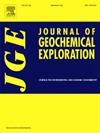Iron and phosphate species regulates arsenic speciation and potential mobility in contaminated soils
IF 3.3
2区 地球科学
Q1 GEOCHEMISTRY & GEOPHYSICS
引用次数: 0
Abstract
Arsenic in soils poses a high environmental risk. The understanding of arsenic geochemical speciation, mobility, and other potential factors in contaminated soils is crucial for appropriate remediation strategy development and environmental assessment. The objective of this study was to investigate the arsenic oxidation state and its form in each step of sequential extraction applied to different types of contaminated soils, and to analyze the impact of sequential extraction forms of soil Fe and phosphate. Soil samples were collected from three agricultural regions: acid mine drainage (AMD)-impacted red soils (n = 5, 61.1–248.6 mg As/kg) and As-contaminated groundwater-impacted soil including yellow soils (n = 6, 23.2–32.1 mg As/kg) and chestnut soils (n = 5, 9.0–13.3 mg As/kg). The results of sequential extraction revealed that As was primarily associated with Fe(III) oxyhydroxides. The highest proportion of amorphous Fe(III) oxyhydroxide-bound As was observed in the southern red soils, which was attributable to the coprecipitation/immobilization of high Fe and As concentration levels in AMD during irrigation. The amount of adsorbed As (mass fraction) increased linearly with increasing amounts of As and is related to the presence of both amorphous and crystalline Fe phases in the soils. This demonstrates the immobilization role of reactive Fe phases in controlling the potential mobility of As in contaminated soils impacted by As-contaminated groundwater and AMD. Soil phosphate, with mass concentrations 2–4 orders of magnitude higher than those of As, occupied most of the Fe(III) oxyhydroxide reactive sites. Phosphate-extractable As was 4.3–80.7 mg/kg, accounting for 18.3–76.0 % (median of 33.5 %) of total As, indicating the competitive effect of phosphate on the desorptive release of As. The AMD-impacted paddy soil exhibited much higher proportions of phosphate-extractable As and a predominance of As(III) in the water-soluble extract, revealing the high potential mobility and toxicity of As in flooded soil. The dominant occupation of Fe adsorption sites by soil phosphate likely contributes to low efficiency of soil Fe in immobilizing As. To reduce As mobility, it is imperative to develop future strategies for phosphates used as sustainable fertilizer to support crop culture.
铁和磷酸盐物种调节砷在受污染土壤中的分型和潜在迁移性
土壤中的砷具有很高的环境风险。了解砷在污染土壤中的地球化学特性、迁移性和其他潜在因素,对于制定适当的修复策略和进行环境评估至关重要。本研究的目的是调查不同类型污染土壤在序贯萃取每个步骤中砷的氧化态及其形态,并分析土壤中铁和磷酸盐的序贯萃取形式的影响。土壤样品采集自三个农业地区:受酸性矿井排水(AMD)影响的红壤(n = 5,61.1-248.6 mg As/kg)和受砷污染的地下水影响的土壤,包括黄壤(n = 6,23.2-32.1 mg As/kg)和栗土(n = 5,9.0-13.3 mg As/kg)。顺序萃取的结果表明,砷主要与铁(III)氧氢氧化物相关联。在南部红壤中观察到的无定形铁(III)氧氢氧化物结合砷的比例最高,这是因为在灌溉过程中,高浓度的铁和砷在 AMD 中发生了共沉淀/移动。吸附的 As 量(质量分数)随 As 量的增加而线性增加,这与土壤中存在无定形和结晶铁相有关。这表明反应性铁相在控制受砷污染的地下水和 AMD 影响的受污染土壤中砷的潜在迁移性方面起着固定作用。土壤中磷酸盐的质量浓度比砷的质量浓度高 2-4 个数量级,占据了大部分氢氧化铁(III)氧反应位点。磷酸盐可萃取砷为 4.3-80.7 毫克/千克,占砷总量的 18.3%-76.0%(中位数为 33.5%),表明磷酸盐对砷的解吸释放具有竞争效应。受 AMD 影响的稻田土壤中磷酸盐可萃取砷的比例更高,水溶性萃取物中以 As(III)为主,这表明砷在水淹土壤中具有很高的潜在迁移性和毒性。土壤磷酸盐主要占据铁的吸附位点,这可能是土壤中铁固定砷的效率较低的原因。为了减少砷的流动性,必须为磷酸盐作为支持作物栽培的可持续肥料制定未来战略。
本文章由计算机程序翻译,如有差异,请以英文原文为准。
求助全文
约1分钟内获得全文
求助全文
来源期刊

Journal of Geochemical Exploration
地学-地球化学与地球物理
CiteScore
7.40
自引率
7.70%
发文量
148
审稿时长
8.1 months
期刊介绍:
Journal of Geochemical Exploration is mostly dedicated to publication of original studies in exploration and environmental geochemistry and related topics.
Contributions considered of prevalent interest for the journal include researches based on the application of innovative methods to:
define the genesis and the evolution of mineral deposits including transfer of elements in large-scale mineralized areas.
analyze complex systems at the boundaries between bio-geochemistry, metal transport and mineral accumulation.
evaluate effects of historical mining activities on the surface environment.
trace pollutant sources and define their fate and transport models in the near-surface and surface environments involving solid, fluid and aerial matrices.
assess and quantify natural and technogenic radioactivity in the environment.
determine geochemical anomalies and set baseline reference values using compositional data analysis, multivariate statistics and geo-spatial analysis.
assess the impacts of anthropogenic contamination on ecosystems and human health at local and regional scale to prioritize and classify risks through deterministic and stochastic approaches.
Papers dedicated to the presentation of newly developed methods in analytical geochemistry to be applied in the field or in laboratory are also within the topics of interest for the journal.
 求助内容:
求助内容: 应助结果提醒方式:
应助结果提醒方式:


